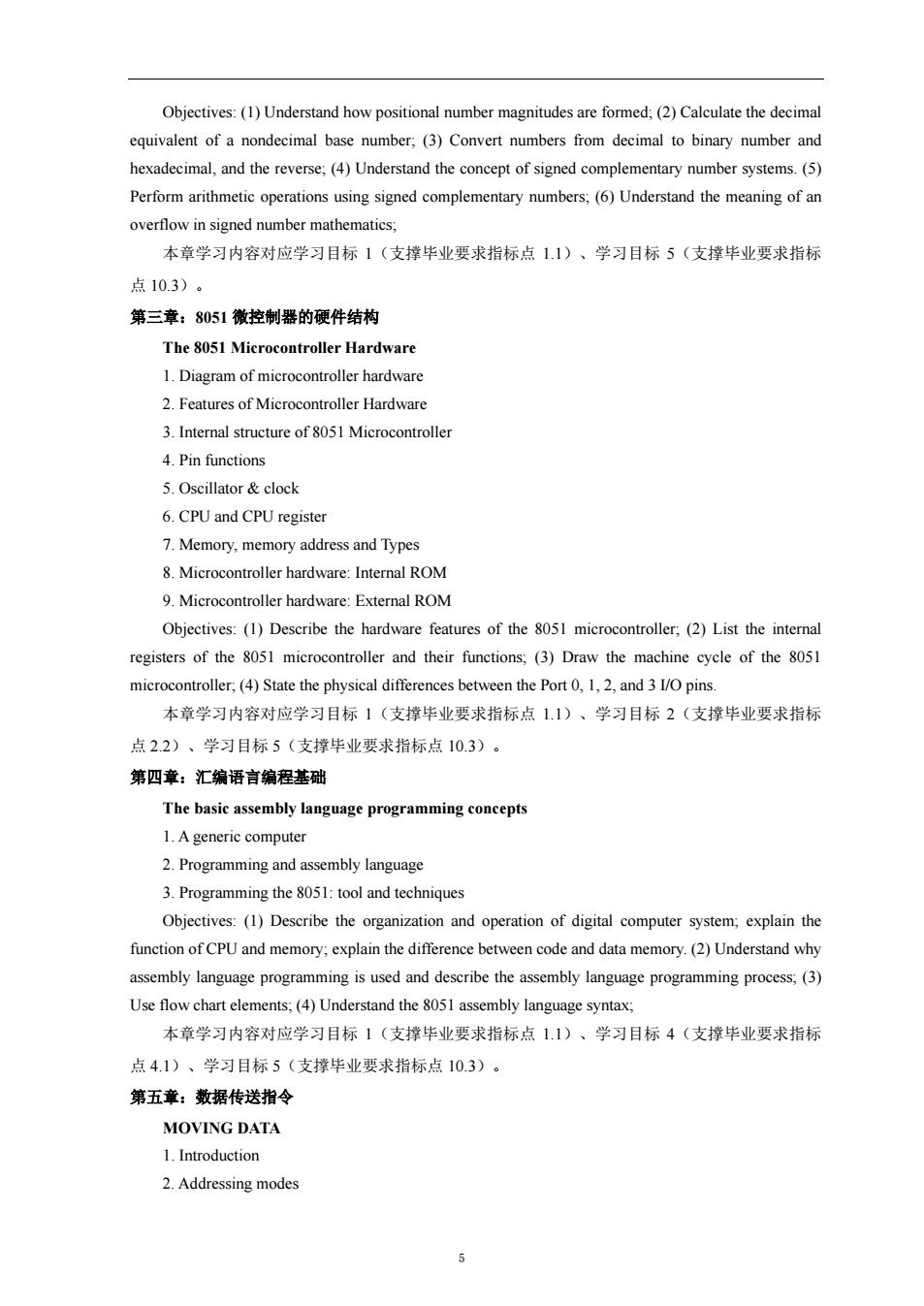正在加载图片...

Objectives:(1)Understand how positional number magnitudes are formed:(2)Calculate the decimal equivalent of a nondecimal base number,(3)Convert numbers from decimal to binary number and hexadecimal.and the reverse:(4)Understand the concept of signed complementary number systems.(5) Perform arithmetic operations using signed complementary numbers,(6)Understand the meaning of an overflow in signed number mathematics: 本章学习内容对应学习目标1(支撑毕业要求指标点11)、学习目标5(支撑毕业要求指标 点10.3)。 第三章:8051徽控制器的硬件结构 The 8051 Microcontroller Hardware 1.Diagram of microcontroller hardware 2.Features of Microcontroller Hardware 3.Internal structure of 8051 Microcontroller 4.Pin functions 5.Oscillator clock 6.CPU and CPU registe 7.Memory,memory address and Types 8.Microcontroller hardware:Internal ROM 9.Microcontroller hardware:External ROM Objectives:(1)Describe the hardware features of the 8051 microcontroller,(2)List the interna registers of the 8051 microcontroller and their functions:(3)Draw the machine cycle of the 8051 microcontroller,(4)State the physical differences between the Port ,1,2,and 31/O pins. 本章学习内容对应学习目标1(支撑毕业要求指标点1.1)、学习目标2(支撑毕业要求指标 点2.2)、学习目标5(支撑毕业要求指标点103)。 第四章:汇编语言编程基础 The basic assembly language programming concepts 1.Ageneric computer 2.Programming and assembly language 3.Programming the 851:tool and techniques Objectives:(1)Describe the organization and operation of digital computer system;explain the function of CPU and memory:explain the difference between code and data memory.(2)Understand why assembly language programming is used and describe the assembly language programming process:(3) Useflow chart elements (4)Understand the 851assembly language syntax 本章学习内容对应学习目标1(支撑毕业要求指标点1.1)、学习目标4(支撑毕业要求指标 点4.1)、学习目标5(支撑毕业要求指标点10.3)。 第五章:数据传送指令 MOVING DATA 1.Introduction 2.Addressing modes Objectives: (1) Understand how positional number magnitudes are formed; (2) Calculate the decimal equivalent of a nondecimal base number; (3) Convert numbers from decimal to binary number and hexadecimal, and the reverse; (4) Understand the concept of signed complementary number systems. (5) Perform arithmetic operations using signed complementary numbers; (6) Understand the meaning of an overflow in signed number mathematics; 本章学习内容对应学习目标 1(支撑毕业要求指标点 1.1)、学习目标 5(支撑毕业要求指标 点 10.3)。 第三章:8051 微控制器的硬件结构 The 8051 Microcontroller Hardware 1. Diagram of microcontroller hardware 2. Features of Microcontroller Hardware 3. Internal structure of 8051 Microcontroller 4. Pin functions 5. Oscillator & clock 6. CPU and CPU register 7. Memory, memory address and Types 8. Microcontroller hardware: Internal ROM 9. Microcontroller hardware: External ROM Objectives: (1) Describe the hardware features of the 8051 microcontroller; (2) List the internal registers of the 8051 microcontroller and their functions; (3) Draw the machine cycle of the 8051 microcontroller; (4) State the physical differences between the Port 0, 1, 2, and 3 I/O pins. 本章学习内容对应学习目标 1(支撑毕业要求指标点 1.1)、学习目标 2(支撑毕业要求指标 点 2.2)、学习目标 5(支撑毕业要求指标点 10.3)。 第四章:汇编语言编程基础 The basic assembly language programming concepts 1. A generic computer 2. Programming and assembly language 3. Programming the 8051: tool and techniques Objectives: (1) Describe the organization and operation of digital computer system; explain the function of CPU and memory; explain the difference between code and data memory. (2) Understand why assembly language programming is used and describe the assembly language programming process; (3) Use flow chart elements; (4) Understand the 8051 assembly language syntax; 本章学习内容对应学习目标 1(支撑毕业要求指标点 1.1)、学习目标 4(支撑毕业要求指标 点 4.1)、学习目标 5(支撑毕业要求指标点 10.3)。 第五章:数据传送指令 MOVING DATA 1. Introduction 2. Addressing modes 5